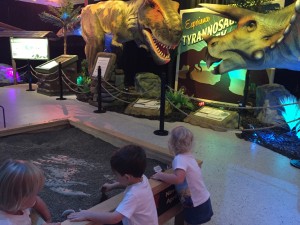Dinosaurs Takeover Palm Beach
By Briana D’Andrea
It was like stepping back in time, when we approached the South Florida Science Museum and Aquarium. Sure, my now 3-year-old son and I have been to the museum on several occasions, but what caught our eye from the parking lot, was unlike anything we had ever seen before! There were two giant dinosaurs waiting to greet us at the entrance of the building. It took us a couple of minutes to admire these life-like pre-historic creatures, before even making it inside.
Once we walked in, it was almost as if we were at our very own “Jurassic Park!” There were more than a dozen immensely sized animatronic dinosaurs that literally took our breath away. Even I was surprised! These life-like creatures moved, blinked their eyes, swung their tails and let out a roar unlike any other!
My toddler was awestruck at the scene recreated dating back more than 270-million years ago. The exhibit was broken up into nine different galleries.
First the original supercontinent, otherwise known as “Pangaea,” which encompassed all of the seven continents on earth, which we have come to know today; North America, South America, Asia, Europe, Africa, Australia and Antarctica. Essentially, this ‘supercontinent’ was one large mass and everything was connected to each other. Here we learned about some of the earliest dinosaurs discovered by scientists and archaeologists.
As we made our way through the exhibit we learned about the different dinosaurs that occupied all of the other continents. In South America, the dinosaurs were a tad smaller in size, measuring from just three to fifteen feet. Although perhaps small in size, these little fellas would lead the path for much larger dinosaurs. Afterwards, we made our way into Europe, where according to findings, housed some very large and violent dinosaurs. When we stepped into Antarctica, we learned that the continent at the time was not in fact a frozen one like it is today. Instead, it was a lush landscape, home to many plant-eating dinosaurs, otherwise known as herbivores. Once we made our way down under to Australia, we were welcomed by a number of other herbivorous dinosaurs, one with quite a unique makeup, that looked almost like an armadillo, covered in armor. Africa was home to some of the worlds most carnivorous dinosaurs, even bigger than the Tyrannosaurus Rex, that would eat baby dinosaurs. Asia housed some interesting looking dinosaurs that resembled birds. These dinos were toothless and had more of a beak-like face. The Velociraptor, also from Asia, was a smaller meat-eating dinosaur that stood on its two toes. Some of the most famous dinosaurs, we have come to know love, as well as fear, were discovered in North America, the T-Rex, one of the largest and most dangerous dinosaur and the Triceratops, one of the last dinosaurs documented, used to the roam the land that we now occupy, which was pretty wild to think about when walking around the exhibit.
The final gallery, marked the end of the dinosaurs 172-million-year reign on planet earth. Scientists believe dinosaurs became extinct thanks to an asteroid that crashed into the Gulf of Mexico. Thus making it one of five mass extinctions during the Earth’s history, that took place more than 65-million years ago.
The exhibit concluded with a station for the youngsters to trace dinosaurs and even dig up fossils, children were also welcome to try on dinosaur costumes, as a grand finale.
The exhibit is really a sight to see and will be on display through April 16, 2016. Get your prehistoric pass today, before they once again become extinct.






